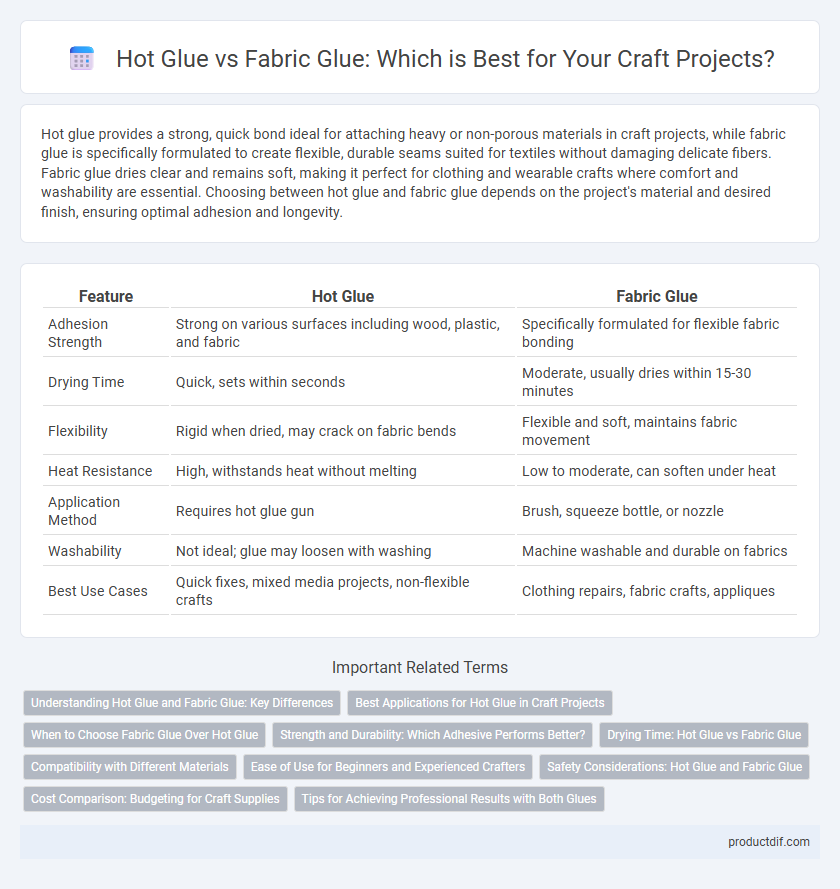Hot glue provides a strong, quick bond ideal for attaching heavy or non-porous materials in craft projects, while fabric glue is specifically formulated to create flexible, durable seams suited for textiles without damaging delicate fibers. Fabric glue dries clear and remains soft, making it perfect for clothing and wearable crafts where comfort and washability are essential. Choosing between hot glue and fabric glue depends on the project's material and desired finish, ensuring optimal adhesion and longevity.
Table of Comparison
| Feature | Hot Glue | Fabric Glue |
|---|---|---|
| Adhesion Strength | Strong on various surfaces including wood, plastic, and fabric | Specifically formulated for flexible fabric bonding |
| Drying Time | Quick, sets within seconds | Moderate, usually dries within 15-30 minutes |
| Flexibility | Rigid when dried, may crack on fabric bends | Flexible and soft, maintains fabric movement |
| Heat Resistance | High, withstands heat without melting | Low to moderate, can soften under heat |
| Application Method | Requires hot glue gun | Brush, squeeze bottle, or nozzle |
| Washability | Not ideal; glue may loosen with washing | Machine washable and durable on fabrics |
| Best Use Cases | Quick fixes, mixed media projects, non-flexible crafts | Clothing repairs, fabric crafts, appliques |
Understanding Hot Glue and Fabric Glue: Key Differences
Hot glue, made from thermoplastic adhesives, offers fast bonding and high temperature resistance, ideal for quick fixes and non-porous materials. Fabric glue, designed with flexible polymers, provides a strong, washable bond tailored for textiles, maintaining fabric softness without stiffness. Choosing between hot glue and fabric glue depends on project demands, material type, and desired durability, ensuring optimal craft supply performance.
Best Applications for Hot Glue in Craft Projects
Hot glue is ideal for quick bonding and crafting with materials like wood, plastic, and foam due to its strong adhesion and fast drying time. It excels in projects requiring immediate hold, such as assembling decorations, attaching embellishments, and creating 3D models. Fabric glue, while suitable for textiles, lacks the heat-resistant strength and durability that hot glue offers in mixed-material craft applications.
When to Choose Fabric Glue Over Hot Glue
Fabric glue is best chosen over hot glue when working with delicate or lightweight fabrics that require a flexible, washable bond without the risk of heat damage. It provides a smoother finish and is ideal for bonding multiple layers of fabric or detailed embellishments that might melt or warp under high temperatures. Fabric glue also excels in projects needing long-lasting adhesion with less mess or cleanup compared to hot glue guns.
Strength and Durability: Which Adhesive Performs Better?
Hot glue offers immediate bonding strength ideal for quick fixes and non-washable projects, but it may become brittle and lose adhesion over time on flexible fabrics. Fabric glue is specifically formulated to maintain flexibility and strong adhesion through multiple washes, providing long-lasting durability on textile surfaces. For projects requiring enduring strength with fabric resilience, fabric glue outperforms hot glue in maintaining both bond integrity and fabric texture.
Drying Time: Hot Glue vs Fabric Glue
Hot glue dries within seconds to a minute, providing an almost instant bond ideal for quick fabric crafting projects. Fabric glue typically requires 20 to 30 minutes to dry fully, allowing for repositioning before it sets permanently. The choice between hot glue and fabric glue depends on the need for speed versus flexibility in drying time during craft assembly.
Compatibility with Different Materials
Hot glue provides strong adhesion on a wide range of materials including wood, plastic, metal, and thick fabric, but may not be suitable for delicate or heat-sensitive fabrics due to its high temperature application. Fabric glue is specifically formulated for textiles, offering flexible and durable bonds on cotton, polyester, silk, and other delicate materials without damaging fibers or causing stiffness. Choosing between hot glue and fabric glue depends on the material compatibility, with fabric glue preferred for soft, washable fabrics and hot glue ideal for robust or mixed-material craft projects.
Ease of Use for Beginners and Experienced Crafters
Hot glue offers quick bonding and strong adhesion, making it ideal for both beginners and experienced crafters seeking fast and reliable results. Fabric glue provides a more flexible hold and is easier to apply precisely, preferred by those working with delicate fabrics or detailed designs. Both adhesives require minimal setup, but hot glue demands caution due to high temperature, while fabric glue allows for safer, mess-free usage.
Safety Considerations: Hot Glue and Fabric Glue
Hot glue poses burn risks due to its high melting temperature, requiring careful handling and protective equipment to prevent skin injuries. Fabric glue, typically non-toxic and solvent-free, offers a safer alternative for children and sensitive skin, although some formulas may cause irritation if ingested or exposed to prolonged contact. Proper ventilation is essential with certain fabric adhesives containing volatile organic compounds (VOCs) to minimize respiratory hazards.
Cost Comparison: Budgeting for Craft Supplies
Hot glue offers an economical solution for crafters requiring fast adhesion, with bulk glue sticks priced around $10 to $15 for 50 sticks, making it cost-effective for large projects. Fabric glue typically costs more, averaging $5 to $10 per tube of 2 to 4 ounces, which suits detailed textile applications but may increase budget constraints. Considering project scope and material type, hot glue minimizes overall expenses while fabric glue provides specialized bonding, influencing supply budgeting decisions based on adhesive needs.
Tips for Achieving Professional Results with Both Glues
Use hot glue for quick, strong bonds on thicker fabrics and embellishments, applying thin, even layers to avoid lumps and mess. For delicate or heat-sensitive materials, fabric glue offers flexible, washable adhesion; apply sparingly and allow adequate drying time to prevent stiffness. Always test glue on a fabric scrap first to ensure compatibility and durability for professional, lasting craft projects.
Hot glue vs Fabric glue Infographic

 productdif.com
productdif.com